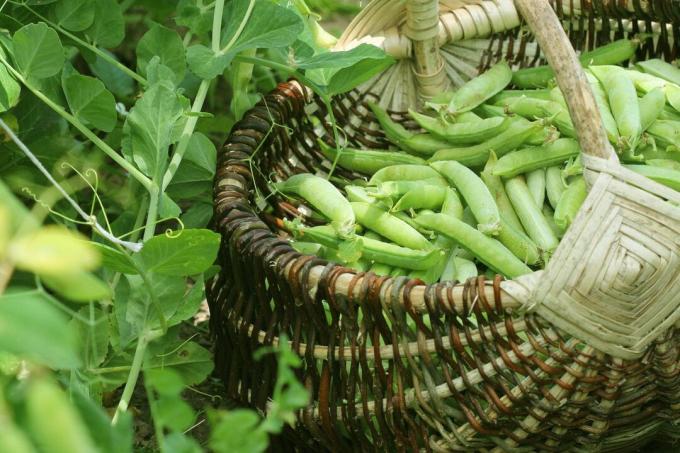Successful cultivation is followed by harvesting and storage of the pea plant as well. Everything about how to harvest and store peas properly can be found here.

Pea plants (Pisum sativum) produce many legumes over the summer. You can easily cover your need for peas with a few plants. But how can you actually tell from the outside when peas are ripe and how can they be stored? We'll show you the best way to go from harvest to storage.
contents
- Harvesting peas: the right time
- How to harvest peas
- Use of peas: with or without a pod?
-
Freeze peas and store properly
- Freeze peas
- Dry peas
- Reduce the peas
Harvesting peas: the right time
While most vegetables are just beginning to grow properly, many are Pea varieties already ripe and waiting for their harvest. In general, it is worth planting peas with a time lag and planting different varieties so that you can harvest them gradually in summer. The following applies to the ripening of peas: peas (
Pisum sativum L. convar. Sativum) can be harvested as early as the end of May, marker peas (Pisum sativum L. convar. medullare Aleph.) and sugar peas (Pisum sativum L. convar. axiphium Aleph.) are ready from June.
However, the appearance of the pods is more important than the exact month. Because the pods can be used to determine the degree of ripeness quite easily. If the peas are already clearly visible in the pods, they should be harvested. Leaving the green peas on the plant longer than necessary can give them a floury taste. For sugar peas, the pods should be at least 5 cm long. But don't wait too long here either, otherwise these will become fibrous.
Our tip: Check your population regularly from May / June.
Pay attention to the following when harvesting:
- Harvest for pea peas from the end of May, for pulp and sugar peas from June
- Correct harvest time when peas are clearly visible in pods
- Pith and pea peas become floury when overripe
- Sugar peas become fibrous when overripe

How to harvest peas
Harvesting peas is quite straightforward and doesn't require any sharp tools. Check your plants regularly in summer and break off mature specimens at the roots. Of course, you can also snap off the peas with secateurs. It is advisable to take a bowl with you when collecting, as a lot of peas can be harvested on the tour.
Use of peas: with or without a pod?
The term pod is often used for peas, although botanically speaking it is actually a pod. When growing peas, it depends on the variety whether you can eat them or not. While pith and pea peas are chopped off and only the fresh, green peas are used, the pods can be eaten with sugar peas. The choice of the variety depends entirely on personal taste.

by the way: Peas are the only legumes (Leguminosae) that can be eaten raw. This applies to both the sugar snap peas and the peas themselves. But be careful with other legumes like Beans - these always have to be cooked!
Freeze peas and store properly
In summer it often happens that more peas have to be harvested at once than you would like to use in the kitchen. Fortunately, there are a few ways to properly store these protein-rich vegetables. We introduce several.
Freeze peas
Peas are very suitable for freezing - this way they stay crisp and fresh. To increase the shelf life, the peas are first briefly blanched in boiling water and then quenched with cold water. Either a freezer bag or a normal container for food can be used for freezing. When using the freezer bag, make sure that there is no more air in the bag before it is frozen.

Dry peas
Drying peas is ideal for very long storage. Dried peas can easily be kept for up to a year. To dry, either leave the peas in the pods for a few days or remove them beforehand. If you want to save a little time, we recommend drying in the oven. At 50 ° C, the peas can be kept in the oven within a few hours and can then be filled into glasses.

Reduce the peas
A classic method of storing vegetables is canning, which also works great with peas. To do this, proceed as follows: Rinse and boil a mason jar with its rubber seal properly so that it does not get dirty. Pour the fresh peas into the glass. This is then followed by topping up with water, after which the jar has to be properly closed. Now boil the peas in the glass at 100 ° C for about 2 hours. You can either use a water bath in the oven or a cooking pot for this. A major disadvantage of canning, as opposed to freezing, is the loss of freshness in the peas. Nevertheless, the method is well suited to preserve the vegetables for several months.
Like you new next year Sow peas, learn from this article.



